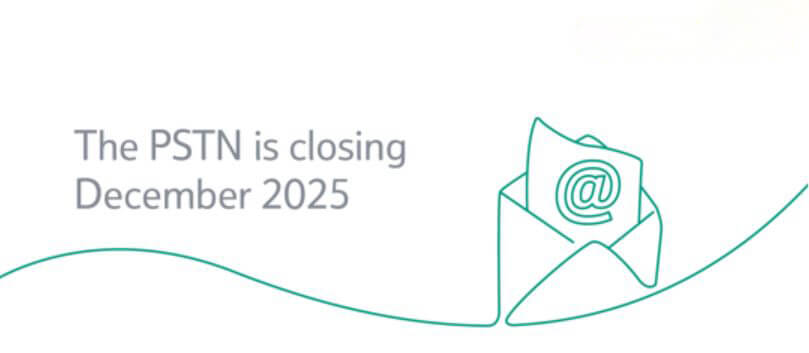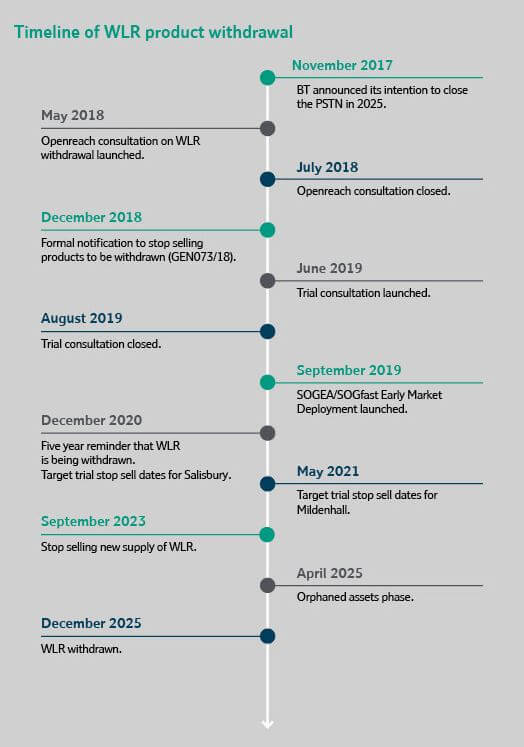PSTN & ISDN Switch Off
The Public Switched Telephone Network (PSTN)
PSTN and ISDN are coming to the end of life in 2025, find out how this may affect your business.

Don’t panic. Be properly prepared
What’s going on?
The PSTN switch off is coming!
The PSTN (Public Switched Telephone Network) will be switched off in 2025, which means everyone, including businesses, currently using PSTN-based services will need to move to another service before then.
All ISDN/PSTN voice services will go to complete end-of-sale from September 2023 starting with a series of trial zones in the coming months. Stop-sell applies at a premises level where that premise has access to an available FTTP product. Where a premise has access to FTTP there will be no new supply of other products.
What is the PSTN?
We’re all familiar with the copper wire telephone network: in use since 1876, it’s kept business communications’ going for years.
The Public Switched Telephone Network (PSTN) delivered over WLR (Wholesale Line Rental) forms alarge proportion of the UK telecoms infrastructure.
Its functions include connecting voice calls using analogue voice data and supporting digital servicessuch as ISDN (Integrated Services Digital Network).
Broadband products also rely on this service to work.
But that’s all about to change.
Why are they being phased out?
Although they’ve been the most reliable solutions to date, PSTN and ISDN are rapidly becoming out of date technology, and expensive to operate and maintain.
Openreach plans to invest instead in fibre infrastructure rather than further invest in a new version of the PSTN (which is essentially Victorian technology).
Moving to new technologies will open the door to exciting opportunities to develop more reliable and future proof products and services for decades to come.

What products will be affected?
Basic and Premium PSTN lines
ISDN2 /30
Broadband Products that rely on WLR services
The migration will also impact services like security and fire alarms, telecare devices, retail payment terminals and equipment for monitoring and controlling networks.
These rely on some features of the PSTN that are not fully replicated in VoIP-based platforms andcould have implications for both domestic and business customers, as well as public sector users.
What does this mean for you and your business?
Although 2025 may seem like a long way away, it will approach faster than you may think.
So if your current ISDN/PSTN telephony or broadband contract is due for renewal within the next few years, now is the time to start exploring the benefits of VoIP (Voice over Internet Protocol) and SIP (Session Initiation Protocol) services for voice calls, or SoGEA (Single Order Generic Ethernet Access) and FTTP (Fibre to the Premises) for broadband products.
What are SIP, VoIP, SoGEA and FTTP?
Session Initiation Protocol (SIP) is a protocol used inVoice Over Internet protocol (VoIP).
SIP allows users to make voice and video calls globally using computers and mobile devicesthrough an internet connection.
SIP & VoIP offer you flexibility over the traditional fixed line as you are able to make calls anywhere globally as long as you have an internet connection vs being fixed in one location with a traditional connection.
Single Order Generic Ethernet Access (SOGEA) will offer similar connectivity to FTTC (Fibre tothe Cabinet) without the need for an underlying voice access (PSTN) product, offeringspeeds up to 80Mbps. SOGEA has wide availability with coverage in over 28 million UK premises.
Fibre to the Premises (FTTP) is a service offering ultrafast broadband speeds of up to 1Gbps download and 220Mbps upload and can be purchased on its own. FTTP availability in the UK is not as broad as SOGEA but this will expand significantly over the next five years.
SoGEA
Can I keep my current phone number?
You can keep your current phone number if you inform your service provider at point of sale orwhen the migration order is placed, but you will need to take out an OTT IP Voice service (to run parallel with your Single Order Broadband product) and indicate that you wish to port the number on to the new IP Voice service otherwise you will lose the number once the service migrates away from the existing WLR or MPF service.
Why make the switch now?
This is the perfect opportunity for businesses to look at their communications infrastructure andconsider whether it’s truly fit for purpose. With the right technology you can future proof yourcompany while improving current processes, performance and services.
If you’re a business with ambition and you want to continue to grow and engage in ways that are becoming more relevant, embrace the switch off. Move to technology that is application based rather than hardware.
Use the flexibility this infrastructure brings to drive your business forward.
Don’t wait for 2025. You can either be at the leading edge of that change or wait and get caught inthe swell of businesses that didn’t act fast enough.
Our experience in migrating customers really comes to the fore here. Our team can minimise thedisruption’s impact on productivity and process.

What are the next steps and how to prepare?
The change is happening, and you do not want to be left behind.
Orbex Solutions provides end-to-end unified communications and collaboration services to help companies like yours choose the right solutions for your needs.
We will offer a choice of technologies to ensure every customer has a suitable service for the future for both connectivity and telephony.
We can help you migrate your services with minimum disruption to your business.
Get in touch with our team today to explore your options and get ahead of the curve
